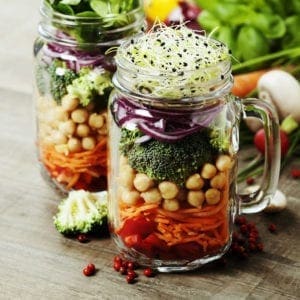Part 1 (click here to read) of international food and restaurant consultants Baum+Whiteman’s view of the hottest F&B trends for 2017 covered the impact of falling food prices, restaurants without seats, seats without restaurants, and the rise in the importance of vegetables. (Update: Read the final Part 3 here.) Here are more of their annual hospitality predictions:

4. Artisan butchers strike back
With hundreds (maybe thousands) of chefs devising new ways to highlight vegetables, there’s bound to be a counter-trend – and here we have it: Glorify great meat by marrying an artisan butcher shop to a restaurant. The idea is to wow consumers with nose-to-tail butchery of humanly-raised (but nonetheless dead) animals that lend their pasture-grazed protein to all manner of charcuterie, innards and odd parts, and newfangled cuts of meat.
Say hello to the “butcher-to-table” trend.
That means fried pigs tails and grilled chicken hearts at Parts & Labor, a meat store-cum-restaurant in Baltimore, along with habanero head cheese, a blizzard of sausages and a creative cut called “lambchetta” (lamb loin and belly seasoned and roasted in the style of porchetta, a dish that seems to be gaining national traction). At Shank Charcuterie in New Orleans, you’ll find whole-animal cuts plus a dining counter with a limited menu of the butchery’s products, including steak and eggs, formed-to-order burgers and house sausages. Everything’s cut, cooked and served by the owner, who seems to enjoy being a one-man band.
More ambitious is a branch of Belcampo Meats in LA’s Grand Central Market, where an expansive meat case abuts a six-stool dining counter and grill that serves up the likes of steak salad and lamburger with garam masala aioli and tamarind chutney (photo, above right).

At Le District Food Hall’s butcher shop in New York’s Brookfield Place – where meat is priced like jewelry – you buy a slab of well marbled steak to cook at home or, for a $12 upcharge, they’ll grill it and dispatch it to your nearby dining table with fries and salad while a waiter delivers your wine. La Grotte des Fromages in Montreal has a similar format, a 50 seat BYOW restaurant where they cook what you’ve selected from their adjacent meat store.
White Gold is a new whole animal butchery to supply April Bloomfield’s growing restaurant empire, The Breslin, Spotted Pig and Salvation Burger in New York. Its restaurant presents trendy off-cuts, charcuterie and familiar steaks and chops. White Gold, which refers to streaks of fat shooting through well-marbled meat, will open for all three meal periods. See also these hybrid and often hipster resto-butchers: Kensington Quarters, Philadelphia (shaved goat leg and charred garlic); The Cannibal, Los Angeles (General Tso’s pig head, photo right); Gwen butcher shop and restaurant in LA from star chef Curtis Stone (glazed cheek, grilled rack and smoked pork belly); Cleaver & Co., New Orleans (smoked wagyu brisket); Salt & Time, Austin (deep fried ribs and waffles at brunch); and Clove & Hoof, Oakland (pig face cubano with rosemary-molasses ham).
5. Breakfast is becoming brunch

After years of denial, McDonalds discovered the virtues of all-day breakfast, and its competitors abruptly ramped up their own offerings. Jack-in-the-Box launched “Brunchfast” with an assortment of heavier items. Starbucks spiced up its breakfast sandwiches and is testing weekend quiche and french toast. Einstein’s launched an LTO of eggs, avocado, chorizo, pepper and jalapeno salsa on a green chile bagel.
Even more exciting: The very texture of breakfast is being transformed. It used to be that breakfast was smooth and soothing – think of soft scrambled eggs, buttered grits, custardy french toast, oatmeal, or varieties of benedicts. Today’s textures (and tastes) are turning aggressive – crunchy fried chicken, sriracha, crispy chorizo, chimichurri, and coarse whole-grain cereal. Smaller chains and independents are creating weightier breakfast items that qualify as round-the-clock meals. And as a merchandising ploy, they also are promoted as hangover helpers!
- Breakfast sandwiches are making waves as millennials demand speed, high-protein, and portability where possible. Trendoids should watch for a.m. sandwiches packed with gonzo ingredients for maximum flavor. Jam in Chicago fills customers’ bellies with a braised pork shoulder-and-egg sandwich with ricotta salata and green apple ketchup. Eggslut in LA’s Grand Central Market sells the Gaucho, wagyu tri-tip, runny egg over medium, chimichurri, red onions and arugula in a brioche bun (see photo). Seatown in Seattle’s Pike Place Market offers a fried eggwich with jack cheese, avocado and Dungeness crab. Sea & Smoke in Del Mar hawks a ham, cheese, bacon and fried egg sandwich with maple syrup on a cinnamon roll. Deep Ellum in Boston offers house-smoked kielbasa, fried egg, horseradish aioli and cheddar in an English muffin. Mike & Patty’s Boston breakfast torta contains two fried eggs, cheddar, jalapeños, potatoes, black beans, salsa and avocado.
 The national obsession with fried chicken has invaded formerly soothing breakfasts. Astro Donuts in DC has honey-butter fried chicken served in a donut. The Big Nasty Biscuit at Hominy Grill in Charleston is topped with fried chicken, cheddar and sausage gravy. Empire State South, Atlanta, tops its chicken biscuit with pimento cheese, bacon marmalade and scrambled eggs. At Free Range in LA you get tempura chicken, honey, sriracha and scrambled eggs.
The national obsession with fried chicken has invaded formerly soothing breakfasts. Astro Donuts in DC has honey-butter fried chicken served in a donut. The Big Nasty Biscuit at Hominy Grill in Charleston is topped with fried chicken, cheddar and sausage gravy. Empire State South, Atlanta, tops its chicken biscuit with pimento cheese, bacon marmalade and scrambled eggs. At Free Range in LA you get tempura chicken, honey, sriracha and scrambled eggs.
- Keep your eyes on elaborate breakfast tacos. Not as portable as morning burritos but more fun to behold, and gastronomically more complex. Choza’s in New York’s Gotham West Market (right) is heaped with eggs, jack cheese, pica de gallo and carnitas or chorizo. The Don Juan from Juan in a Million, Austin, has chopped bacon, an entire potato, two eggs and cheddar.
6. Hail kale…and farewell!
It looks like dreaded kale has reached its peak, at least when it comes to consumer packaged goods, so savvy restaurateurs should focus on what’s next. According to Whole Foods’ former global grocery coordinator, kale “continues to disappear from snacks while sea vegetables find new formats”. One reason for the rise of various seaweeds is the ramen explosion all across the country, where seaweed is the foundation of many broths. Seaweed also packs a wallop of umami and chefs are sneaking it into finishing salts and oils, in fish sauce, and incorporating it into pasta. David Burke’s newest restaurant features seaweed-soaked roasted chicken.
Kale has no monopoly in the new “waste-not” economy, so more chefs are using beet greens, chard, turnip greens, mustard greens, carrot tops, many items often previously discarded. You’ll be seeing special menus that specifically utilize otherwise wasted vegetable stems and trims, thereby getting plaudits from eco-conscious diners. Chefs will be pickling these things and using them as condiments.
If we’re wrong, hedge your bets by exploring the world of squashes.
7. Fast-casual growth: Is there no end?
There seemed no limit to how much traffic the growing crop of fast-casual restaurants could steal from casual dining chains and fast food outfits. Until late 2016, when customer counts turned down a bit, to everyone’s surprise. Maybe it’s a statistical blip. Or maybe too many fast-cas startups are diluting the market – and maybe the entire field is getting overcrowded.
After all, how many fast-cas pizza chains do we really need? And how many artisan hamburgers can the market support?
The danger, in our opinion, is a formulaic experience from one fast-cas to another that ultimately becomes boring. Choose a (fill in the blank), add a (fill in the blank), top it with (fill in the blank) and garnish it with (fill in the blank). Your food will be (choose any three) local, sustainable, farm-to-table, mindfully sourced, natural, artisan, eco-friendly, authentic, healthy, humanely slaughtered, meaningful, seasonal, vegetable-forward, mission-driven, chef-driven.
Well, yes … these are all good intentions, but their incessant repetition leaches their meaning. Creative entrepreneurs are adapting all manner of cuisines to the 1-2-3 format. Chicken, rotisserie or fried; hummus, falafel and shwarma; Indian-fusion; Asian-fusion; Chinese-fusion; bowls of all kinds, with Korean coming up fast (see trend #8, below); all manner of ethnic sandwiches – banh mi, tortas and cemitas, cubanos – mostly dumbed down; lots of Mediterranean copycats; more-or-less vegetarian; grilled cheese; global burritos; lobster rolls; salad bars; poke and ceviche.
Interesting that Red Robin scrapped its fast-cas burger experiment just as Chipotle is opening its own, all the while dithering with its Pizza Locale and Shop House concepts, much to the financial market’s skepticism.

Perhaps the most adventurous fast-cas startup is Mark Peel’s Bombo Foods in LA’s Grand Central Market. It is cooking up an interesting menus of meals-in-bowl, primarily fish, using a bank of steam-jacketed kettles, with prices in the $11-$14 range: steamed mussels with curried shrimp cream; steamed clams and sausage in lobster broth (photo, right). Attach this to a bar and you’ve got a hot rollout … we think. (See also “Bowls They Said” below)
Possibly, too many fast-cas startups are outrunning the trend cycle for these sorts of service forms, so there’ll be serious rethinking about how to differentiate one chain from another – a quandary that has plagued fast food for a generation. Could be that decor will shift up a couple of notches to mimic casual dining environments; there will be the addition of cocktails and other alcoholic beverages from full bars with appropriate decor, or delivery of food to tables, which will make these places more like restaurants; or the addition of drive-thru service, which will make them more like fast food. Or both.
Sounds to us like the young fast-casual field is ripe for some re-invention (see Trend #12).
8. Bowls, they said
 It all began innocuously with acai bowls for breakfast (what happened to acai, anyway?). Then it spread to fast-casual when chains discovered their customers were rejecting breads and wraps in favor of greens and grains. And then the poke craze arose, and all manner of raw seafood began appearing in bowls. The ramen trend accelerated eating from bowls – never mind that most noodles are bread in another form. Koreans have always served in bowls, so we have the mainstreaming of bibimbap (see photo).
It all began innocuously with acai bowls for breakfast (what happened to acai, anyway?). Then it spread to fast-casual when chains discovered their customers were rejecting breads and wraps in favor of greens and grains. And then the poke craze arose, and all manner of raw seafood began appearing in bowls. The ramen trend accelerated eating from bowls – never mind that most noodles are bread in another form. Koreans have always served in bowls, so we have the mainstreaming of bibimbap (see photo).
Office workers are discovering that takeaway bowls are less likely to spatter their laps and laptops and chefs are finding that assembling a decorous bowl is easier and faster than the complexity of plating upscale entrees because they don’t have to fuss around with all that white space. What’s more, if you hold a bowl Buddha-like while eating, you are psychologically more prone to mindfulness about your meal. You’ll also stand a better chance of catching all the flavors and textures with every bite, and think you’re full a lot faster, even if you chuck the white carbs.
9. Oddball ice creams getting hot
 Had your “freakshake” yet? This demented fad began in Australia, took root in the UK (perhaps to soothe Brexit angst) and landed in the US, where Black Tap in New York is arguably the Big Dipper of the country. Explanation: A freakshake is a freestyle milkshake topped ice cream, as much sauce and whipped cream as possible, and then surmounted by insane quantities of cake, cookies, donuts, ice cream sandwiches and various candies until the concoction threatens intellectually and physically to topple.
Had your “freakshake” yet? This demented fad began in Australia, took root in the UK (perhaps to soothe Brexit angst) and landed in the US, where Black Tap in New York is arguably the Big Dipper of the country. Explanation: A freakshake is a freestyle milkshake topped ice cream, as much sauce and whipped cream as possible, and then surmounted by insane quantities of cake, cookies, donuts, ice cream sandwiches and various candies until the concoction threatens intellectually and physically to topple.
Horrifying to nutritionists everywhere, these heart attacks-in-a-glass run rampant on Instagram. They cost between $12 and $15 – more if boozed up. You can find examples at The Original Dinerant in Portland topped with coffee syrup, an entire buttermilk donut and mocha caramel. The Boston Burger Co. decks one out with M&Ms, sprinkles, a cupcake and gummy worms. You’ll find others at Nashville’s Burger Republic and Seattle’s Lunchbox Laboratory. See also: Sugar Factory in Las Vegas, Orlando and New York. Among the biggest cardio offenders is Black Tap in New York (see photo), but they’ve had the decency not crown theirs with mini-burgers or fried chicken parts as some shops have.
Since children should be forbidden to even see one of these frankenshakes, many places turn them into adult beverages by boozing them up. In fact, cocktails are heading in the same direction. The $40 Sumo Mary from Asian-fusion Sunda in Chicago is a 32-oz. eyepopper topped with bacon, bread, Chinese broccoli, roasted potatoes, sometimes a duck bao or braised pork belly or shishito peppers.
Roll Me One: Keep an eye on ice cream rollups – another decorative import, this time from Thailand – into New York’s Chinatown and then outward. Ice cream rollups are thin layers of liquid ice cream frozen into crepe-like thinness on a super-cooled metal plate, like the old Coldstone Creamery, and then scraped into tight cylinders with what looks like a putty knife. These rollups are placed in a cup and garnished with relative restraint compared to a Freakshake. It take two minutes to freeze and roll a portion, but this is done in front of customers so there’s entertainment value. Places serving these creations have popped up Chicago, Philly, Atlanta, Montreal, Boston and New York … and chainlets are in the making.
 CPR for Fro-Yo: There’s a painful fallout among frozen yogurt shops in the US, the result of faddish over-storing everywhere and of rising rents that can’t be supported by low-check purchases. Suggest you visit London’s Milk Train dessert shop, where crowds line up for a soft-serve cone embedded in a huge cloud of cotton candy (called “candy floss” there). It sticks to your hands, hair and clothes, and afterward you’ll want to run through the carwash. So far as we know, no sadist has yet brought this creature to the US – but just you wait!
CPR for Fro-Yo: There’s a painful fallout among frozen yogurt shops in the US, the result of faddish over-storing everywhere and of rising rents that can’t be supported by low-check purchases. Suggest you visit London’s Milk Train dessert shop, where crowds line up for a soft-serve cone embedded in a huge cloud of cotton candy (called “candy floss” there). It sticks to your hands, hair and clothes, and afterward you’ll want to run through the carwash. So far as we know, no sadist has yet brought this creature to the US – but just you wait!
You’ll also want to research other frozen desserts trending from Southeast Asia, including variously decorated shaved ices.
Savory Flavors: And for the health-obsessed, watch for lots of vegetables being added to ice creams and ice pops – avocado, for example, gazpacho, sweet corn kernels, sweet pepper, sweet potato, pumpkin, roasted beet-goat cheese.
But wait there more! If you missed Part 1, have a read of it here or read the final Part 3 by clicking here.
About the source
Baum+Whiteman creates high-profile restaurants around the world for hotels, restaurant companies, museums and other consumer destinations. Based in New York, their projects include the late Windows on the World and the magical Rainbow Room, and the world’s first food courts. They also run F&B trends seminars for major hotel and restaurant companies. They currently are working in Dubai, New York and Florida. Contact: Michael Whiteman 718 622 0200 mw@baumwhiteman.com.







 The national obsession with fried chicken has invaded formerly soothing breakfasts. Astro Donuts in DC has honey-butter fried chicken served in a donut. The Big Nasty Biscuit at Hominy Grill in Charleston is topped with fried chicken, cheddar and sausage gravy. Empire State South, Atlanta, tops its chicken biscuit with pimento cheese, bacon marmalade and scrambled eggs. At Free Range in LA you get tempura chicken, honey, sriracha and scrambled eggs.
The national obsession with fried chicken has invaded formerly soothing breakfasts. Astro Donuts in DC has honey-butter fried chicken served in a donut. The Big Nasty Biscuit at Hominy Grill in Charleston is topped with fried chicken, cheddar and sausage gravy. Empire State South, Atlanta, tops its chicken biscuit with pimento cheese, bacon marmalade and scrambled eggs. At Free Range in LA you get tempura chicken, honey, sriracha and scrambled eggs.











